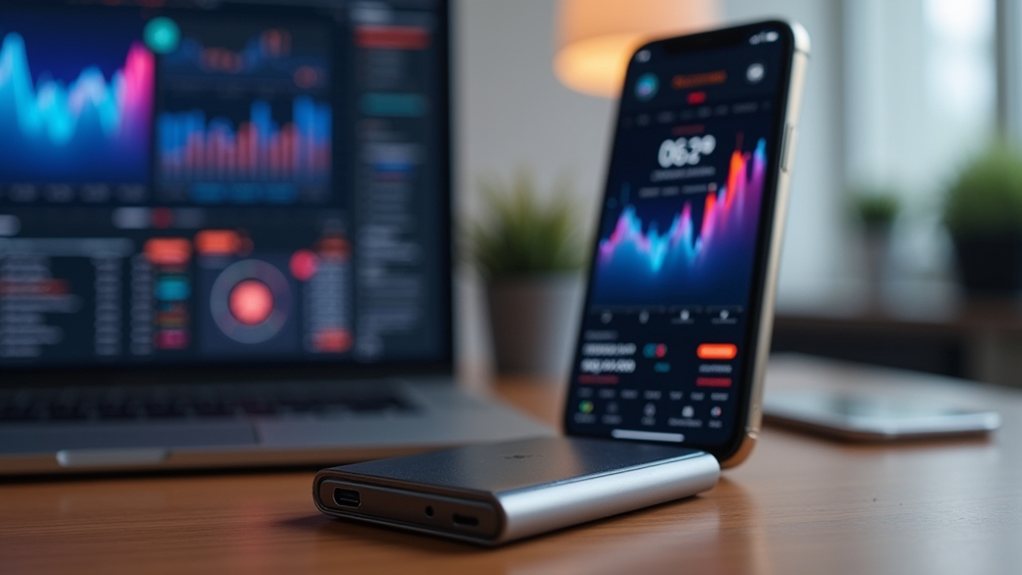A DeFi wallet is a digital tool that gives users complete control over their cryptocurrencies without third-party involvement. Unlike traditional banking, these self-custody wallets let owners manage their private keys directly. They support multiple digital assets and connect to decentralized exchanges for trading, staking, and yield farming. DeFi wallets come in various forms including mobile apps, browser extensions, hardware devices, and paper versions. Security features and user experience continue to evolve in this growing space.

The gateway to decentralized finance, a DeFi wallet serves as a digital tool that allows users to store and manage their cryptocurrencies while connecting to various financial services. Unlike traditional wallets offered by exchanges or banks, these specialized wallets give users complete control over their digital assets. This self-custody approach means users hold their private keys—the critical passwords that prove ownership of cryptocurrency—instead of trusting a third-party company to manage them.
DeFi wallets support multiple cryptocurrencies and tokens, making them versatile tools for crypto users. They connect directly to decentralized exchanges where users can swap tokens without intermediaries. These wallets also enable participation in yield farming, where users can earn rewards by providing liquidity to trading pools. Users can stake their assets to earn passive income or access lending platforms to borrow or lend cryptocurrency. Some networks employ Proof of Stake mechanisms that allow users to validate transactions and create new blocks by staking their cryptocurrency. Popular options like MetaMask, Coinbase Wallet, and Trust Wallet offer various features to access the Web3 services ecosystem.
Versatility defines DeFi wallets, allowing users to swap tokens, farm yields, stake assets, and access crypto lending—all without intermediaries.
There are several types of DeFi wallets available to meet different needs. Software wallets include mobile apps and browser extensions that offer convenience and regular use. Hardware wallets provide enhanced security by storing private keys offline. Web-based wallets offer accessibility through internet browsers, while paper wallets store information physically offline. Multi-signature wallets add security by requiring approval from multiple parties.
Security remains a top priority for DeFi wallet developers. Most wallets encrypt private keys and sensitive data to protect users. Many incorporate two-factor authentication and biometric verification like fingerprint or face recognition. Regular security updates help address vulnerabilities, and some wallets integrate with hardware devices for extra protection.
Modern DeFi wallets emphasize interoperability, allowing users to work across different blockchain networks. They support cross-chain transactions, enabling assets to move between systems like Ethereum and Binance Smart Chain. This compatibility lets users access a wider range of DeFi protocols and applications without switching between multiple wallets.
User experience has improved considerably in recent years. Today's DeFi wallets feature intuitive interfaces with real-time portfolio tracking. Many include in-app browsers for accessing DeFi websites and detailed transaction histories. Users can often customize settings like gas fees—the costs paid to process transactions on blockchains.
Despite their advantages, DeFi wallets come with responsibilities and risks. Users must safeguard their recovery phrases and private keys, as losing these means losing access to funds permanently. The wallets may connect to protocols with smart contract vulnerabilities. Users face potential phishing attacks targeting their credentials. User errors can lead to irreversible mistakes, and regulations around DeFi remain unclear in many regions. Non-custodial DeFi wallets provide users with the ability to store over 1000 tokens across 30+ blockchains simultaneously.
These factors make DeFi wallets powerful tools that require careful handling.
Frequently Asked Questions
How Secure Are Defi Wallets Compared to Centralized Exchanges?
DeFi wallets offer better security than centralized exchanges in several ways. They don't store user funds or private keys on central servers that hackers target.
Users maintain complete control of their assets through their private keys. While centralized exchanges face risks of hacks and insolvency, DeFi wallets eliminate these concerns.
However, they shift responsibility to users, who must safeguard their seed phrases or risk permanent loss of funds.
Can I Recover My Defi Wallet if I Lose My Seed Phrase?
Recovery of a DeFi wallet without a seed phrase is nearly impossible.
Unlike traditional banking, there's no "forgot password" option. Industry experts estimate billions in cryptocurrency remains permanently locked due to lost seed phrases.
While some wallets offer alternative recovery methods like social recovery or multisig options, these must be set up beforehand.
Once a seed phrase is lost, the funds typically can't be accessed again.
What Are the Gas Fees Associated With Defi Wallet Transactions?
Gas fees for DeFi wallet transactions vary depending on network congestion.
Ethereum-based transactions often have higher fees during busy periods. Users pay these fees to miners who process their transactions.
Fees include a base fee plus an optional priority fee for faster processing. The complexity of a transaction also affects costs.
Some DeFi wallets now offer layer 2 solutions that markedly reduce these fees.
Are Defi Wallets Compatible With All Blockchain Networks?
DeFi wallets aren't compatible with all blockchain networks. Most support Ethereum and EVM-compatible chains, where over 80% of DeFi activity happens.
Some wallets like MetaMask support 50+ networks, while others specialize in specific blockchains like Phantom for Solana. Multi-chain wallets such as Trust Wallet can handle 40+ blockchains.
Users often need multiple wallets for thorough coverage across different blockchain ecosystems.
How Do I Connect My Defi Wallet to Dapps?
Connecting a DeFi wallet to DApps is straightforward. Users visit the DApp's website and click the "Connect Wallet" button.
They then select their wallet from the options shown. The wallet interface will display a connection request that needs approval.
After confirming, the wallet address appears in the DApp interface. For security, experts recommend disconnecting wallets when not actively using a DApp.










